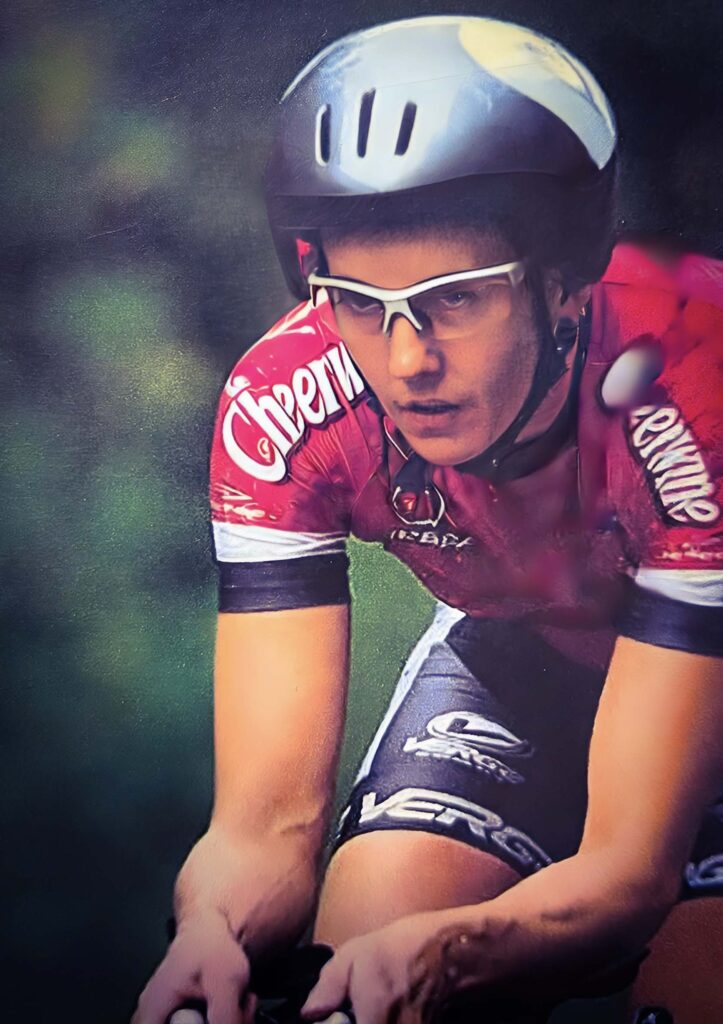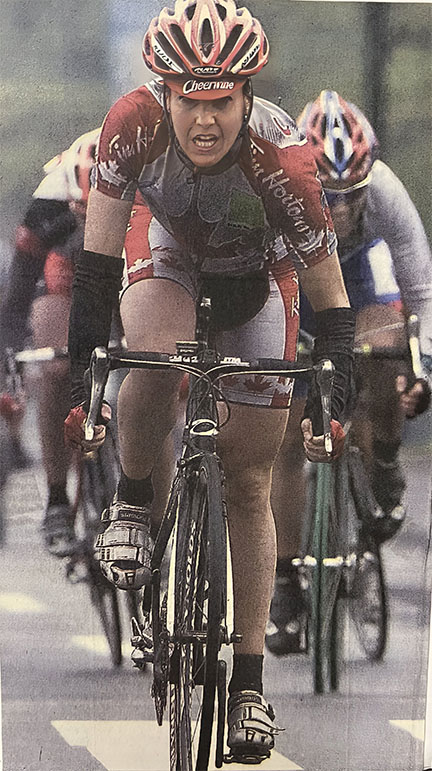
By the time Leigh Hobson competed in the Olympics, she was 37 years old and firmly ensconced in a teaching career at Galt Collegiate.
This probably made her better able to appreciate her Bejing 2008 Olympic experience.
The World Cup cyclist placed third at Canadian Championship Road Races in 1996, 2000 and 2006 and was a member of Canada’s national cycling team from 1997 to 2000, and from 2007 to 2008.

She has competed in the women’s Tour de France and the Giro D’Italia world championships, and in 2008 was Cambridge Athlete of the Year.
The GCI teacher was an inspiration not only because of her many highs in sport, but also of the way she overcame adversity, tackling the many challenges and injuries she dealt with along the way, all the while juggling a demanding career.
No sooner did she return from China than she was back in the classroom at GCI.
“I think it’s going to take more time to sink in that it’s actually over…especially now that I’m right back to teaching,” she said at the time. “It’s been great seeing everyone again and sharing stories from Beijing. The students are really excited about it!”
Hobson planned to retire from competitive cycling following the Olympics.

“I’d planned to return to teaching as soon as this season was over,” she told Canadian Cyclist Magazine’s Anne Guzman that September. “They gave me an extended leave of absence, and I really wanted to return to the same school. I made that decision very early on in my comeback to cycling…it helped me have a specific goal and timeline.”
Hobson began racing in 1995, and with the exception of a two-year break, had been cycling for about 11 years in total by the time she qualified for the 2008 Olympics.
As a university student she competed in triathlons. “I heard about a road race at Hidden Valley and was all ready to sign up for a running race when I realized it was road cycling…so I thought, what the heck…I’ll give it a try. My dad came with me to the race (he used to race himself). Because I had the mindset of pacing myself (from running), I asked my dad to time my laps and yell out my splits…he gave me this incredulous look and said…if they go hard…you go hard! I took his advice, and hung on to the finish of my first novice race. The sponsor of the race, Ziggy’s, gave me a jersey to wear instead of my tri-top I was racing in. I joined the club that fall and the rest is history.”
That racing history began in earnest in 1997 when she raced for her first professional team. Eric Wohlberg put in a good word for her and Shaklee, from California, took her on for the spring racing season. Wohlberg opened a lot of doors, she said.
But there were plenty of challenges along the way. One such challenge was getting good results in order to prove herself to the professional managers of the US trade teams.
“Finding the balance between working to pay the bills and training full time to get results was another challenge,” she said. Her aim was always to peak at Nationals so that she would be selected for National team events.
Over the years as a professional racer, she was a member of several professional racing teams. But finding her way in the sport was a complicated process.
“Each team was different,” she said. “Some had larger budgets than others, some had better managers than others, and some had better riders than others. By far my favorite team was Cheerwine…primarily because we had a solid core of amazing women who were committed to the team and to each other.”
As she gained experience in the sport’s signature competitions—she counts the Tour de Thuringen as her favourite—she began to entertain notions about making Canada’s Olympic team.
“Canadian women had about a year and a half to make the Olympic pool of athletes vying for the three Olympic spots,” she explained. “If you were in the pool, you could then focus your season around the Olympics. I think it was important for the final qualifiers to be selected just prior to the Olympics. Cycling can be so up and down…you want the athletes chosen to be going well the year of the Games (not necessarily those who might have gone well in the past).”
That meant that cyclists would have to peak once in the spring, and then again in August for the Olympics. But Hobson said it isn’t uncommon for cyclists to have two peaks a year, once at Nationals, and then later, at Worlds.
Injuries were part of her sport.“It was very tough because it felt like my fitness was always being set back. I think it was one of the factors that contributed to my taking a hiatus from the sport in 2000…I had a plate put in my collarbone, started teaching and changed my focus for a little while.”
Her advice to aspiring professional female racers? “Be realistic about the challenges, but don’t let them deter you from pursuing cycling on a professional level. If you really want it bad enough, you’ll be persistent and the doors will open. Have short-term goals along the way to help you keep your motivation when things don’t seem to be going the way you want them to. But most of all…keep your love for the sport alive in the ways that work for you!”
She collected several stage wins in various events such as the Redlands Bicycle Classic, the Women’s Tour of New Zealand and the Tour of the Gila.
She also finished third at the 2008 La Coupe du Monte Cycliste Feminine de Montreal, and third at the National Championships Road Race in 2000 and 2006, before finishing second in 2008 and earning one of three spots on the Canadian Olympic team.
True to her word, following her retirement, she stayed on to coach after Beijing. It was during those post-Olympic years that she suffered her most serious cycling injury, making her earlier collarbone fractures seem minor in comparison. It happened while coaching Ontario’s provincial junior cycling team in South Carolina in March of 2013.
Speeding down a hill, a dog bolted out and ran into Hobson’s bike, throwing her over the handlebars. She landed on the back of her head. It was so serious that she was airlifted to a hospital.
Her helmet proved a lifesaver, though she suffered a serious concussion.
“I’ve had crashes before, but I’ve never had one where I couldn’t get back on my bike,” she said. “I’ve never felt anything like this.”
It was many months before Hobson was able to get back on her bike, only after struggling through nausea, vertigo, and lethargy, and going on long-term disability.
Recovery was a long, slow process involving intensive physiotherapy. When she was finally able to return to GCI, it was not as a gym teacher but as a special ed teacher, and only part-time.
When she was finally able to get back on her bike, Hobson cycled with her husband along the Grand River at a much slower pace than what she was used to.
“I just thought, ‘Whoa. How far I’ve fallen,’” she said.
Make a donation today, and support the Cambridge Sports Hall of Fame.
Cambridge Centre Mall
425 Hespeler RoadUnit #6, PO Box 444 Cambridge, Ontario N1R 8J6
General inquiries: info@cambridgeshf.com Archives and Nominations: cshf1@live.com
© 2025 All Rights Reserved.